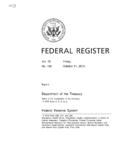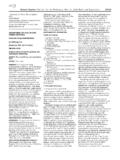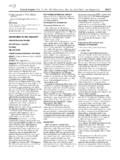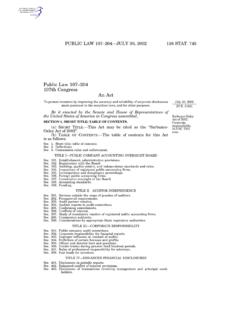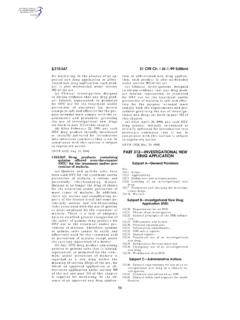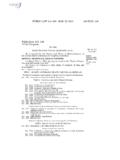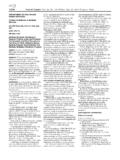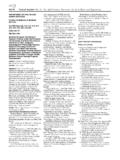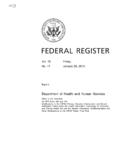Transcription of Weld repair of the U. S. Capital dome - GPO
1 Nisr National Institute of Standards and Technology Technology Administration, United States Department of Commerce NIST Technical Note 1500-10. Materials Reliability Series weld repair of the Capitol Dome T. A. Siewert C. N. McCowan R. A. Bushey J. Doherty T. Christ D. J. Kotecki D. L Olson L W. Myers, Jr. E. Hinshaw S. Kiser NIST Technical Note 1500-10. Materials Reliability Series weld repair of the Capitol Dome T. A. Siewert and C. N. McCowan Materials Reliability Division, Materials Science and Engineering Laboratory National Institute of Standards and Technology R. A. Bushey, J. Doherty, and T. Christ ESAB Welding and Cutting Products D. J. Kotecki Lincoln Electric Corp. D. L. Olson Colorado School of Mines L. W. Myers, Jr. Consultant E.
2 Hinshaw and S. Kiser Special Metals, Inc. A Report to the Office of the Architect of the Capitol on Project 900265 K. December 2002. DEPARTMENT OF COMMERCE. Donald L. Evans, Secretary TECHNOLOGY ADMINISTRATION. Phillip J. Bond, Under Secretary for Technology NATIONAL INSTITUTE OF STANDARDS AND TECHNOLOGY. Arden L. Bement, Jr., Director National Institute of Standards and Technology Technical Note 1500-10. Stand. Technol., Tech. Note 1500-10, 38 pages (December 2002). Natl. Inst. CODEN:NTNOEF. GOVERNMENT PRINTING OFFICE. WASHINGTON: 2002. For sale by the Superintendent of Documents, Government Printing Office Internet: Phone: (202) 512-1800 Fax: (202) 512-2250. Mail: Stop SSOP, Washington, DC 20402-001. weld repair of the Capitol Dome*. A Report to the Office of the Architect of the Capitol, for project 900265K.
3 Siewert and McCowan National Institute for Standards and Technology'. Bushey. J. DoherU'. and T. Christ ESAB Welding and Cutting Products Kotecki Lincoln Electric Corp. Olson Colorado School of Mines Myers. Jr. Consultant (formerly with Dresser Rand E. Hinshaw and S. Kiser Special Metals Inc. This report describes some options for weld repairs to the outer shell of the dome on the Capitol. During the past 140 years, corrosion products ha\'e built up within many of the joints, leading to cracking of some of the iron castings that form the shell. Since the dome is a national landmark, the goal is to restore the stmcmral integrity of the original castings, replacing as few of the components as is absolutely necessary^ WTiile mechanical joining of the fractures or filling of the gaps with epoxy are alternati\'e procedures, a fLised (leak-tight) and ductile joint is preferred.)
4 A major challenge is that the castings were produced with 1850's technology, so the composition is far different from current castings that are designed for weld repair . Therefore, we chose to develop some altemati\"e approaches, designed specifically for the dome castings. Of the \'arious options, oxyacetylene braze welding (a flame repair process where the tiller metal melts at a temperature belowthat of the casting) with low-fuming bronze (about 60Cu- 40Zn) worked The bronze forms joints that are ver\" similar in strength to best. the castings. A joining trial m Jul\" 2002 demonstrated the utilit}' of this technique in the flat and \"ertical positions at four comer cracks on the dome. More information on the dome material itself is included in a related report.
5 Metallurgy of the Capitol Dome. XIST Technical Note 1500- 11. Keywords: braze welding; bronze, cast iron: corrosion, low-fummg bronze: ox\'acer\'lene. *Tradenames ser\"e only to identify- products: neither endorsement nor criticism is intended. 1. 1. Introduction The activities tit into two separate segments, a short project in 1998, and a follow-on project in 2002. The first project involved a relatively simple screening approach to the problem, and resulted in a recommended procedure. When a joining trial in 1998 showed that this procedure was less than fully successful, the second project was developed. The second project developed two more recommended procedures, and included a field trial on the dome. Since the second project built on what was learned in the first, it seems best to describe them chronologically in the following sections.
6 2. Development of the First Procedure (1998). Background ^. In June of 1998, a group of researchers from NIST visited with staff from the Office of the Architect of the Capitol to learn whether their skills could help with the planned restoration of the Capitol Dome. Also at the meeting were two outside experts who had been involved with past restoration efforts: Richard Kadlubowski of Hoffmann Architects, the consultant for the rehabilitation of thedome, and A. J. "Bud" Julicher, an independent structural engineer who is familiar with the weld repair that was completed about 992 on the cast-iron ring at the base of 1. "Freedom", the statue at the veiy top of the dome. The restoration efforts have been given a high priority, now that moisture is leaking into some of the interior areas of the building.
7 The goal is to restore the dome to its original condition, with minimal replacement of castings. Therefore, welding is an important option for repair of cracks and corrosion damage to the castings. We learned that the present dome of the was designed in the 1850's by Thomas U. Walter Capitol and built between 1856 and 1866. It replaced an earlier wooden dome that was no longer in scale with the recent expansions to House and Senate wings (expansions needed to accommodate legislators from the states that had just been added to the Union). A masonry dome was ruled out because the existing Rotunda walls could not support the mass of the larger dome. However, calculations showed that the Rotunda could support a cast-iron dome, which could be cast with cutouts in areas where material was not required.
8 In addition, cast iron was fire resistant, could be formed in complex shapes, and could be erected with pieces of convenient sizes. The designers also recognized that the dome would be subject to movement due to heating and cooling cycles, and the design included features to accommodate this movement. The Capitol Dome was the second cast-iron dome in the world, and remains the world's largest iron dome to this day. Although the majority of the dome, complete with its inner and outer shells and lower skirt, is composed of cast iron, wrouglit iron was used in a few places. The main framing of the dome consists of 36 arched ribs that bear on 36 paired pillars that, in turn, bear on 36 pairs of cast-iron brackets that are embedded in the masonry walls of the Great Rotunda.
9 The ribs are tied together at multiple levels by bands or hoops, consisting of either cast-iron sections or wrought-iron 2. riveted plates. From the main rib framing, an elaborate arrangement of cast-iron brackets support the outer shell of the dome and give it its distincti\ e shape. The inner shell is suspended from the main ribs with either wTought-iron hangers or cast-iron brackets. Also suspended from the main ribs near the top of the dome is a shell of cast-iron gratings to which the plaster base of the fresco entitled "The Apotheosis of Washington" is applied. At the top of the dome, the 36 ribs com'erge into 12 that continue up^^ ard to support the Tholos and Lantern Le\"els. and the stame "Freedom"". These structtiral parts of the dome were all fabricated in the 1850's and 1860's using the casting technology.
10 " of the time. More information (including Walter's elevation and cross- section drawings from 1859 ) is available at the web site of the .\rchitect of the Capitol [1]. hi a tour through the dome, we saw that the interior rib stmcture (the supporting strucmre) \\ in good condition, but the outer shellhad some cracks and \ isible cortosion at a number of the joints (where paint did not reach the surfaces). The current moisture-leakage problems are all attributed to gaps caused b}' expansion and contraction of the exterior shell and failing filler material in the joints beuveen abutting plates. Most of the joints in the exterior skin are lap or butt joints that are difricult to seal. The leakage has led to corrosion at the joints of the outer shell and railings castings or "v^TOught strucmral forms about 1 cm thick).

